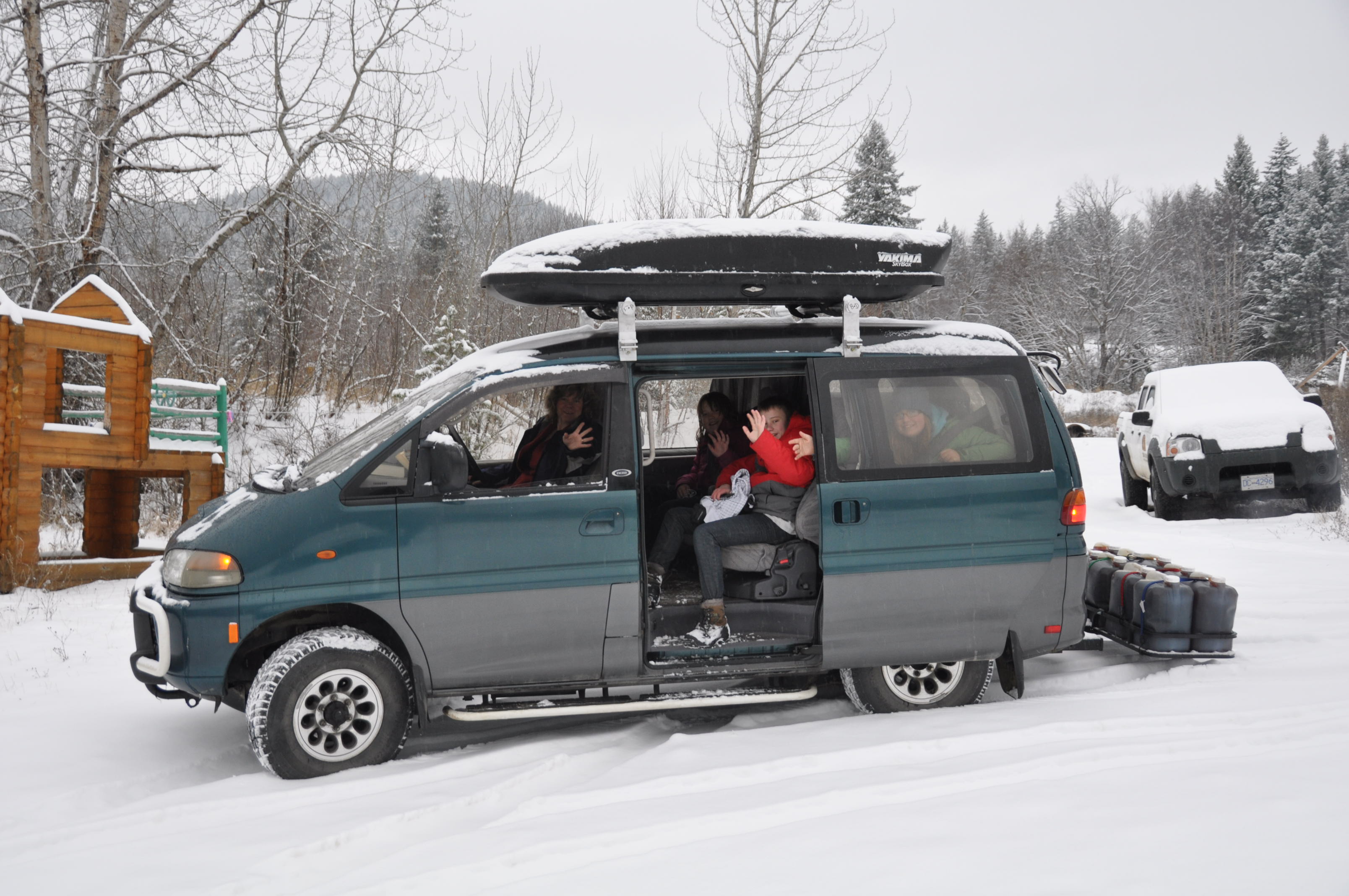
Since leaving Darfield on December 16th we have been SO busy! It is now January 10th and we are in Orlando and I’m just finding time to think about posting. Part of it was the novelty of being on a true “vacation” again and not wanting to do much else. Another part of our slowness to post was that we were both still working remotely and some of our time in the first two weeks was taken up with setting up our access while on the road. Thankfully Chris was able to do this, but it was an added responsibility that he fulfilled in evenings as his days were spent driving or monitoring the various systems on the van.
Better late than never…
The good news is, that overall, the van performed VERY well. The stalling issues that presented itself prior to departure, never did get resolved and after a few stressful moments on on/off ramps on the various highways of Canada, Chris and I decided that as it was not a problem at highway speeds, we would use oil only when at those speeds (most of the time) and flip to diesel on on/off ramps and in city/town driving.
We started the trip with a full tank of oil, which we estimate to be 70 litres. The original tank was 80 litres but to make it fit, Chris had a corner taken off and re-welded. He has the final measurements of the tank, but again, simply hasn’t had the time to do the simple calculation. So for arguements sake, I’ll stick to 70 litres (although I suspect it is slightly more).
We also packed, on the back cargo basket, 10 jugs of oil. Ed Beggs, of plantdrive, indicates these are 16-17 litres each. We pre-filtered this oil at home and filled the jugs to the top. So, add another 170 litres to our departure stock.
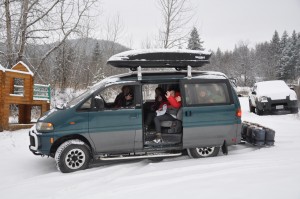
The oil on the back weighed just under 500 pounds. This, with all our gear inside the van, and in the skybox on top, made for a van that looked like it was ready for take-off! I could definitely feel the weight and because of this, we were more cautious driving.
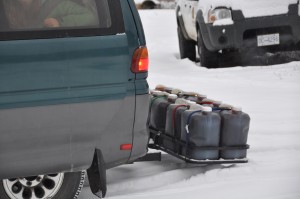
We arrived in Canmore AB the evening of the 16th. We experienced really BAD weather, so it took us longer to drive the 650 kms, mostly because I was driving. I’m one of THOSE drivers in a snowstorm; traffic lines up behind me. Nevertheless we arrived at our first destination that night in 5 pieces (that would be all of us in one piece each!)
My Carleton journalism friend from way back (I mean WAAAYYY back) had her husband collect oil from the restaurants at Lake Louise, AB, where he works as head plumber on the maintenance team. Maureen and Randy’s efforts allowed us to replenish our tank…and more. In fact we left Canmore with the same amount of oil as we started…plus….three more 17 litre jugs! Thanks so much Maurren and Randy! It was also the first time I’d seen Maureen in 20+ years, so I’m thankful used oil brought us together! 🙂
Fortunately the weather on the 17th cooperated and we made good time across the prairies. From my estimates, we can run 10km on a litre of oil. So, a tank of oil generally could take us 700 kms. We usually tried to re-fill the tank every 550 litres, as we weren’t sure initially how far the oil would take us. As we progressed we started to push the limits of the tank.
Chris did start building an arduino sensor to allow us to sense the oil level, and he did hook it up. It gave us relative readings and he never did find time to add the necessary programming to get it to give us more meaninful readings.
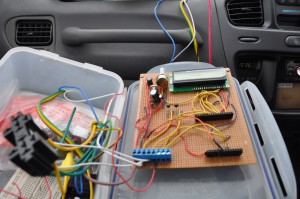
Refilling the tank was strange. Typically we’d stop at a gas station to re-fill. This allowed all of us a bathroom break and to grab a drink if we needed it. We’d park at the gas station, open up the back of the van, start unwinding our hoses from the pump and start pumping oil from the cargo basket. At first, we used the charged motorcylce battery we brought, but when that ran down, we connected the pump to the van battery using our jumper cables. In the future we will run a cable underneath the van and have the clamps in the front of the engine compartment. Feeding the cables through the van and out the window to the battery was not fun!
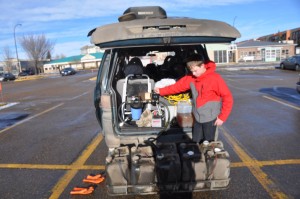
Reaction to our re-filling was…non-existant! Well, we did get some stares as people walked past us, but only ONE person asked us what we were doing and that was the tow truck driver who helped us unlock the van in Strathmore AB (Day 2) when Chris and I managed to lock three sets of keys in the van.
I was disappointed in the reaction. I love to talk about what we are doing. Chris is much lower-key about it, but I think it’s pretty cool, and in reverse I’d be all over it.
Oh well. 🙂
We were very surprised by how far we went on the initial stock of oil. My estimate (I clocked the distances on the odometer when we switched to diesel for significant distances). We essentially went 3100 kms on 320 litres of oil. During that time we filled the diesel tank once (from 1/4 tank to full) as start up and purge times did deplete the diesel. This cost us about $60.
We ran on diesel from Sault Ste. Marie to just outside of London, ON, where Chris’ brother and sister-in-law live, and where we spent Christmas and a few days after.
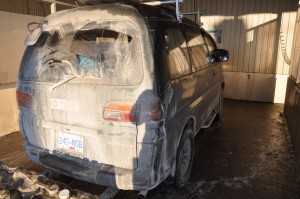
Andrew and Nancy tried to line-up oil for us prior to us arriving. Because it needed to settle before we could use it, they tried to find some mid-December. They didn’t have much luck, being refused at one place outright. Andrew did, however, find somebody selling WVO for $0.89 per litre.
Ugh. Not free, but definitely better than diesel, which was running at a high of $1.42 per litre in northern Ontario.
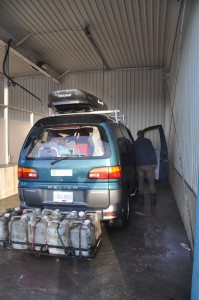
Chris did speak to the fellow who was selling WVO, but was put onto another company that collects and sells WVO in bulk (we’re talking in the 10,000 gallons at a time range). He was intrigued by our oil trip and offered 45 gallons free.
We drove about 30 mins to his collection facility and after an initial reluctance to talk about the WVO business, he opened up and shared. We had no idea that the industry existed like this, and that it was so competitive. Because the US government has mandated 2% “green” content in its deisel the best way to accomplish this is to convert WVO into biodeisel and add it. This “green” deisel apparently sells big-time in Europe. US companies need almost unlimited amounts ofWVO and this fellow, Scott, was collecting from all over Ontario and shipping tanker trucks of it. Who knew? Not us!
Because it is so competitive I can’t say Scott’s last name, or what his company is called. What I can say is that we enjoyed our conversation with him, and were very grateful for the oil. We ended up filling the tank and only 6 containers, with an eye to what our load would look like when we crossed the US border.
We left London on the 29th and headed into Toronto (on oil again) to visit with our Toronto friends and to show more of the city to the kids. Chris took us all through the University of Toronto and showed the kids where he took Fluid Dynamics when in the Engineering Physics program of the Engineering Department. We ate on Bathurst Street and went to the AGO (Art Gallery of Ontario) so Helen could see some original Group of Seven paintings (part of her learning plan for homeschooling). We walked around downtown T.O. a lot.
We left Toronto on January 2nd, full of great memories of the Darbys, Yuyitungs and Hilliers and decided to cross at Kingston. We wanted to use up enough oil before crossing, so that we could disassemble our cargo basket and move the extra oil into the van. I was worried our unorthodox load would slow us down with too many questions. We crossed successfully with a full tank and three and half containers in the back of the van. Most importantly, we left with a full bag of REAL bagels. 🙂
We switched to diesel in New Jersey so that we didn’t stall on the nightmare roads that led into NYC and when we left on the 7th we turned back onto oil. We made it to Fayetteville, North Carolina before we moved back to deisel, making a whopping 4800kms of our 6,000 kms trip propelled on WVO.
We’re now in Orlando, and I’ve put feelers out for oil, to no avail. It is our intention to visit friends in San Francisco, so my next project is to line some up in California. We aren’t fussing too much about it as we are trying to enjoy the trip itself. It’s also easier to stomach the $0.85 per litre cost for deisel here in the U.S.!
I’ve been collecting receipts for costs, but they’ve run away on me. I do know that our accomodation, meals and miscellaneous costs (an emergency buy of electronic device cords, and the $70 break-in-to-the-van-to-get-keys adventure) came to $1,000. Of that, hotels were $500 (we drove late, and took whatever was in front of us) and fuel was about $175. Miscellaneous costs were about $200 and the rest was meals and snacks. At an average price per litre of $1.25 for deisel, we estimate we saved $400 in fuel costs for the first leg of our journey (to Sault Ste. Marie).
Since leaving Canada we’ve spent an obscene amount of money on NYC museums and attractions. It was worth it. We did luck out on a hotel in Queens. Just $114 a night, free parking and breakfast. NYC was great for the kids. We had so much fun with them, culminating with a night out at the musical, Mary Poppins, on my birthday on the 6th. The city is amazing, but I am sure that long-term city living is no longer in my future! Too many people!
Today we purchased a tent and sundry items to put us in camping mode. Not sure what the plans are after Walt Disney World tomorrow, but I think a few beach days may be in order!
I work at Disney World and met Chris a few days ago. Looked at the website and I am really impressed. Thanks for sharing. Hope you are having a wonderful trip here in Orlando. If you still have questions about the aquaponics I may be able to check on that with the fish team. Hope you have a safe and fun vacation while staying here in Orlando. -Toffer